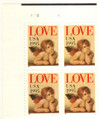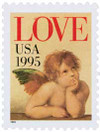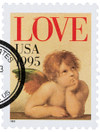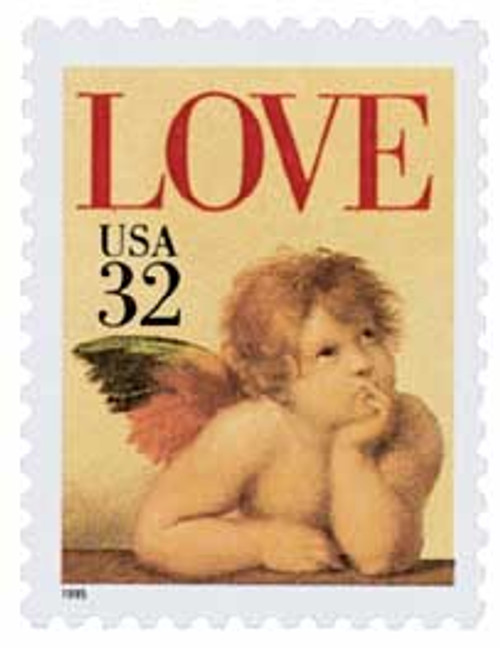
# 2948 - 1995 32c Love Series: Cherub
U.S. #2948
1995 Cherub
- One of six Love stamps issued in 1995 – the most Love stamps issued in a single year up to that point
- The cherub on the stamp was controversial, with some citing such child angels were usually associated with death, not love.
Stamp Category: Commemorative/Special Stamp
Series: Love Series
Value: 32¢, rate for first-class mail
First Day of Issue: February 1, 1995
First Day City: Valentines, Virginia
Quantity Issued: 214,700,000
Printed by: Bureau of Engraving and Printing
Printing Method: Lithographed and Engraved
Format: Panes of 50 from printing plates of 300
Perforations: 11.2
Why the stamp was issued: Love stamps are normally issued predominantly for use on Valentine’s mail. However, the 1995 rate change wasn’t set until late 1994. This non-denominated love stamp was one of two issued in time for the holiday. The 32¢ denominated stamps were issued later in the year. Love stamps are also popular for use on greeting cards and wedding correspondence.
About the stamp design: For the 1995 Love stamp designs, the USPS, was inspired by a postcard picturing two child angels. The angels were taken from Raphael’s massive masterpiece, the 9-foot x 6 ½-foot Sistine Madonna. The USPS thought they would be perfect for Love stamps. The 32¢ stamp features the left-hand angel in a vertical format.
However, C. Douglas Lewis, a curator at the National Gallery of Art and vice chairman of the Citizen’s Stamp Advisory Committee, warned that child angels, also known as putti, were associated with death, not love. The painting is believed to have been commissioned by Pope Julius II, who died before it was completed. Some art historians believe Raphael’s painting had been used at the funeral of Pope Julius II, and that the child angels are resting on top of his coffin.
Eventually, the USPS decided that removing the cherubs from the original painting would let them stand on their own, and were referred to as “cupids” in press materials. The stamps were issued as planned, but media coverage helped stir the controversy. One mother reportedly called to complain that the she had used the Love stamps on her daughter’s wedding invitations and that the “death angel stamps” had jinxed the event.
The debate continued amongst the public. Some agreed that picturing the cherubs on their own put them in a new context, while others still questioned their use on Love stamps. In spite of the controversy, millions of the stamps were sold and the designs remained in use until 1997.
Special design details: This stamp is nearly identical to the 32¢ stamp issued later in the year (#2957) – where “USA 32” replaced “USA 1995.”
First Day City: This stamp, along with a self-adhesive with the same design, was issued at the Robert Clary Building in Valentines, Virginia. This post office receives about 50,000 requests for it special postmark each year.
Unusual fact about this stamp: It was one of seven Love Cherub stamps issued in 1995 and 1996:
US #2948 – 1995 non-denominated first-class rate stamp from sheet
US #2949 – 1995 non-denominated first-class rate stamp from booklet
US #2957 – 1995 32¢ stamp from sheet
US #2958 – 1995 55¢ two-ounce rate stamp from sheet
US #2959 – 1995 32¢ stamp from booklet
US #2960 – 1995 55¢ two-ounce rate stamp from booklet
US #3030 – 1996 32¢ stamp from booklet
About the Love Series: Based on the popularity of Christmas stamps, the USPS issued its first Love stamp in 1973. It wasn’t intended to be the start of a series, and in fact, it wasn’t until 1982 that another Love stamp was issued. Love-themed stamps were issued sporadically over the next few years. The USPS stated that they weren’t intended just for Valentine’s Day mail, but also for weddings, birthdays, anniversaries, and other special occasions. In 1987, the USPS officially declared it a series, and new Love stamps have been issued virtually every year since. Love stamps are classified as “special” stamps. They are on sale longer than commemoratives, are usually printed in greater quantities, and may go back to press to meet demand.
History the stamp represents: Like hearts and flowers, cupids have become a popular symbol of Valentine’s Day. The Roman god of love, Cupid was originally pictured in mythology as a handsome, athletic young man with wings, who carried a bow and arrows. It was believed that the wounds inflicted by his arrows would inspire passionate love in his victims.
By the mid-300s B.C., Cupid was portrayed as a chubby winged infant – a description which still holds true today. Although he was sometimes described as being cold-hearted and callous, Cupid was more often thought of as being well-intentioned with his worst fault being his mischievous matchmaking.
U.S. #2948
1995 Cherub
- One of six Love stamps issued in 1995 – the most Love stamps issued in a single year up to that point
- The cherub on the stamp was controversial, with some citing such child angels were usually associated with death, not love.
Stamp Category: Commemorative/Special Stamp
Series: Love Series
Value: 32¢, rate for first-class mail
First Day of Issue: February 1, 1995
First Day City: Valentines, Virginia
Quantity Issued: 214,700,000
Printed by: Bureau of Engraving and Printing
Printing Method: Lithographed and Engraved
Format: Panes of 50 from printing plates of 300
Perforations: 11.2
Why the stamp was issued: Love stamps are normally issued predominantly for use on Valentine’s mail. However, the 1995 rate change wasn’t set until late 1994. This non-denominated love stamp was one of two issued in time for the holiday. The 32¢ denominated stamps were issued later in the year. Love stamps are also popular for use on greeting cards and wedding correspondence.
About the stamp design: For the 1995 Love stamp designs, the USPS, was inspired by a postcard picturing two child angels. The angels were taken from Raphael’s massive masterpiece, the 9-foot x 6 ½-foot Sistine Madonna. The USPS thought they would be perfect for Love stamps. The 32¢ stamp features the left-hand angel in a vertical format.
However, C. Douglas Lewis, a curator at the National Gallery of Art and vice chairman of the Citizen’s Stamp Advisory Committee, warned that child angels, also known as putti, were associated with death, not love. The painting is believed to have been commissioned by Pope Julius II, who died before it was completed. Some art historians believe Raphael’s painting had been used at the funeral of Pope Julius II, and that the child angels are resting on top of his coffin.
Eventually, the USPS decided that removing the cherubs from the original painting would let them stand on their own, and were referred to as “cupids” in press materials. The stamps were issued as planned, but media coverage helped stir the controversy. One mother reportedly called to complain that the she had used the Love stamps on her daughter’s wedding invitations and that the “death angel stamps” had jinxed the event.
The debate continued amongst the public. Some agreed that picturing the cherubs on their own put them in a new context, while others still questioned their use on Love stamps. In spite of the controversy, millions of the stamps were sold and the designs remained in use until 1997.
Special design details: This stamp is nearly identical to the 32¢ stamp issued later in the year (#2957) – where “USA 32” replaced “USA 1995.”
First Day City: This stamp, along with a self-adhesive with the same design, was issued at the Robert Clary Building in Valentines, Virginia. This post office receives about 50,000 requests for it special postmark each year.
Unusual fact about this stamp: It was one of seven Love Cherub stamps issued in 1995 and 1996:
US #2948 – 1995 non-denominated first-class rate stamp from sheet
US #2949 – 1995 non-denominated first-class rate stamp from booklet
US #2957 – 1995 32¢ stamp from sheet
US #2958 – 1995 55¢ two-ounce rate stamp from sheet
US #2959 – 1995 32¢ stamp from booklet
US #2960 – 1995 55¢ two-ounce rate stamp from booklet
US #3030 – 1996 32¢ stamp from booklet
About the Love Series: Based on the popularity of Christmas stamps, the USPS issued its first Love stamp in 1973. It wasn’t intended to be the start of a series, and in fact, it wasn’t until 1982 that another Love stamp was issued. Love-themed stamps were issued sporadically over the next few years. The USPS stated that they weren’t intended just for Valentine’s Day mail, but also for weddings, birthdays, anniversaries, and other special occasions. In 1987, the USPS officially declared it a series, and new Love stamps have been issued virtually every year since. Love stamps are classified as “special” stamps. They are on sale longer than commemoratives, are usually printed in greater quantities, and may go back to press to meet demand.
History the stamp represents: Like hearts and flowers, cupids have become a popular symbol of Valentine’s Day. The Roman god of love, Cupid was originally pictured in mythology as a handsome, athletic young man with wings, who carried a bow and arrows. It was believed that the wounds inflicted by his arrows would inspire passionate love in his victims.
By the mid-300s B.C., Cupid was portrayed as a chubby winged infant – a description which still holds true today. Although he was sometimes described as being cold-hearted and callous, Cupid was more often thought of as being well-intentioned with his worst fault being his mischievous matchmaking.


















